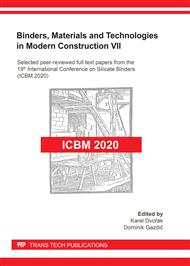p.137
p.143
p.150
p.156
p.162
p.168
p.174
p.181
p.188
Study on Permeability of Concrete Fortifications from WW2 Based on Mercury Intrusion Porosimetry
Abstract:
Quantification of water transport properties of concrete is crucial for prediction of the material degradation processes. In case of 80 years ́ old concrete of fortification structures of former Czechoslovakia, its permeability is the determining factor of the scale of degradation. Mercury intrusion porosimetry was used to characterize the porous system of seven existing bunkers from the defence line ”Pražská čára” and to calculate the permeability using model of Bágel and Živica. Results showed the altered structure of the old concrete, characterized by no notable peaks, which mark the critical pore radius most responsible for water intake. The majority of pores are small micropores, which does not contribute much in the water transport. However, calculated permeability is high enough to be the cause of several degradation processes. The performed program also confirmed high variability of permeability properties between individual structures.
Info:
Periodical:
Pages:
162-167
Citation:
Online since:
October 2021
Authors:
Price:
Сopyright:
© 2021 Trans Tech Publications Ltd. All Rights Reserved
Share:
Citation:


